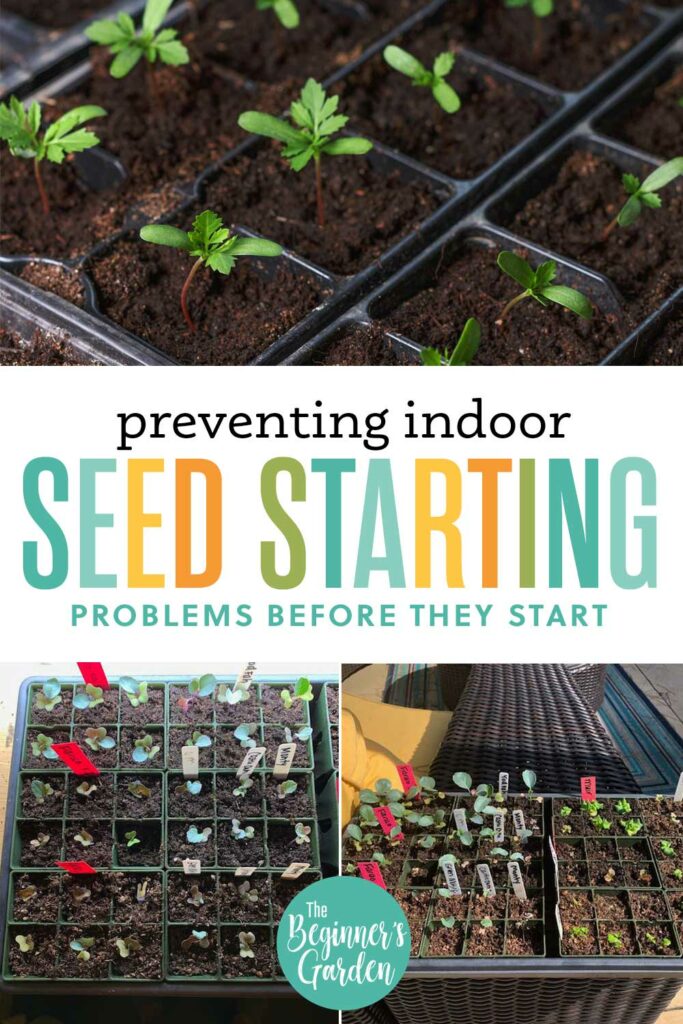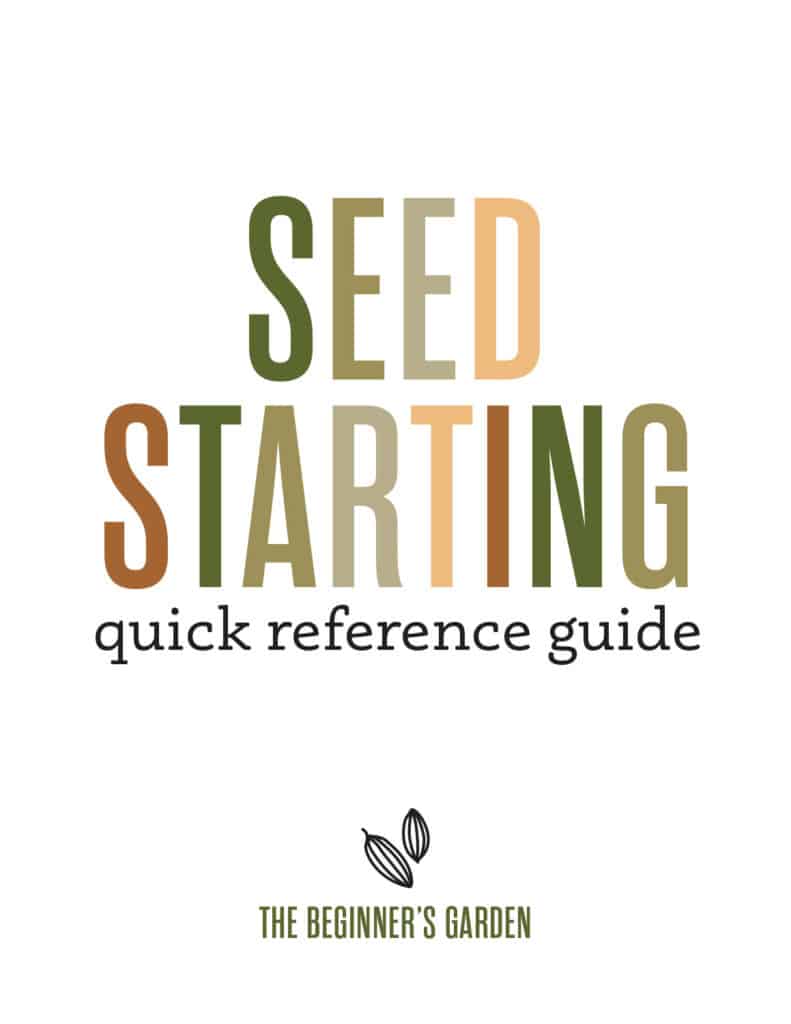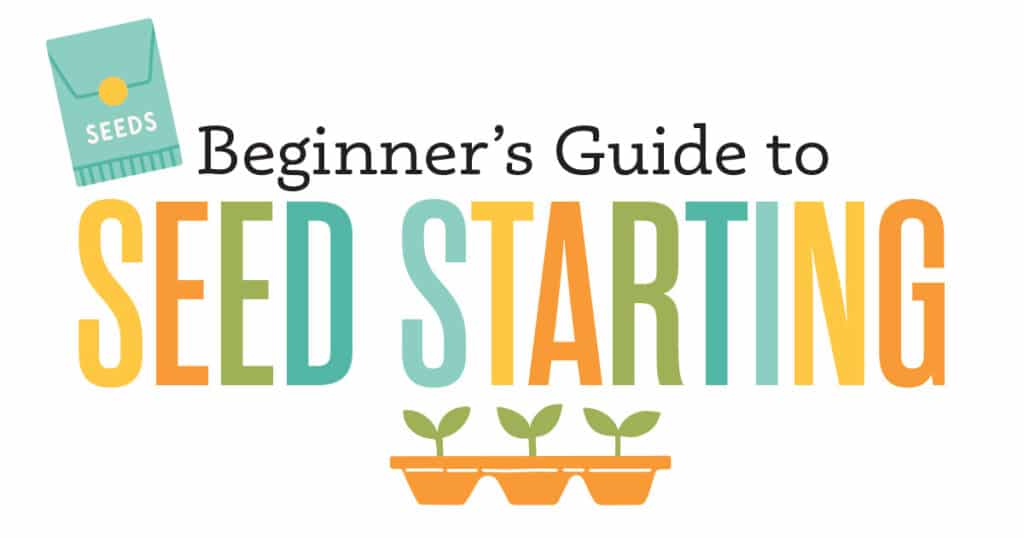Prevent Indoor Seed Starting Problems Before They Start
Learning how to prevent indoor seed starting problems before they start is one key to a successful garden if you choose to start your seeds indoors.
Anytime you plant a seed it’s an act of faith, no matter how many years you have been gardening.
There is a sense of nervousness that comes when you plant a seed in the ground as you are waiting for it to sprout. Many times, beginning gardeners think this is the hardest part, just getting the seedling to break through the soil.
As a seasoned gardener, I can tell you that simply getting the seed to sprout is not the only problem you might face. In fact, lack of germination isn’t nearly as common as the other issues that can occur after your seedling sprouts.
If you’d like to watch a podcast episode instead about how to prevent indoor seed starting problems before they start, you can listen here:
Let’s go over the common indoor seed starting problems that you might face, as well as how to prevent indoor seed starting problems before they even start with these topics:
- Prevent Problems Before They Start
- Indoor Seed Starting Problem #1: Leggy Seedlings
- Indoor Seed Starting Problem #2: Stunted Seedlings
- Indoor Seed Starting Problem #3: Wilting Seedlings
- How To Ensure Indoor Seed Starting Success
Don’t forget to snag your 2024 Garden Planner now before the new year!
Prevent Problems Before They Start
Beginning seed starters often find it difficult to try and identify the problem with newly planted seeds. If you cannot identify the problem with certainty, you are left trying to decide if you should keep nursing unhealthy seedlings or just start over. My goal is to help you prevent indoor seed starting problems before they even begin so you can enjoy the start to your garden.
If you are looking for a guide to follow on how to prevent indoor seed starting problems, you’ll want to grab our Seed Starting Quick Reference Guide.
Indoor Seed Starting Problem #1: Leggy Seedlings
The first and most common indoor seed starting problem I see year after year is leggy seedlings. Leggy seedlings are really tall and spindly with short leaves at the top. There are several reasons why your seedlings could be leggy and the main reason is lack of light.
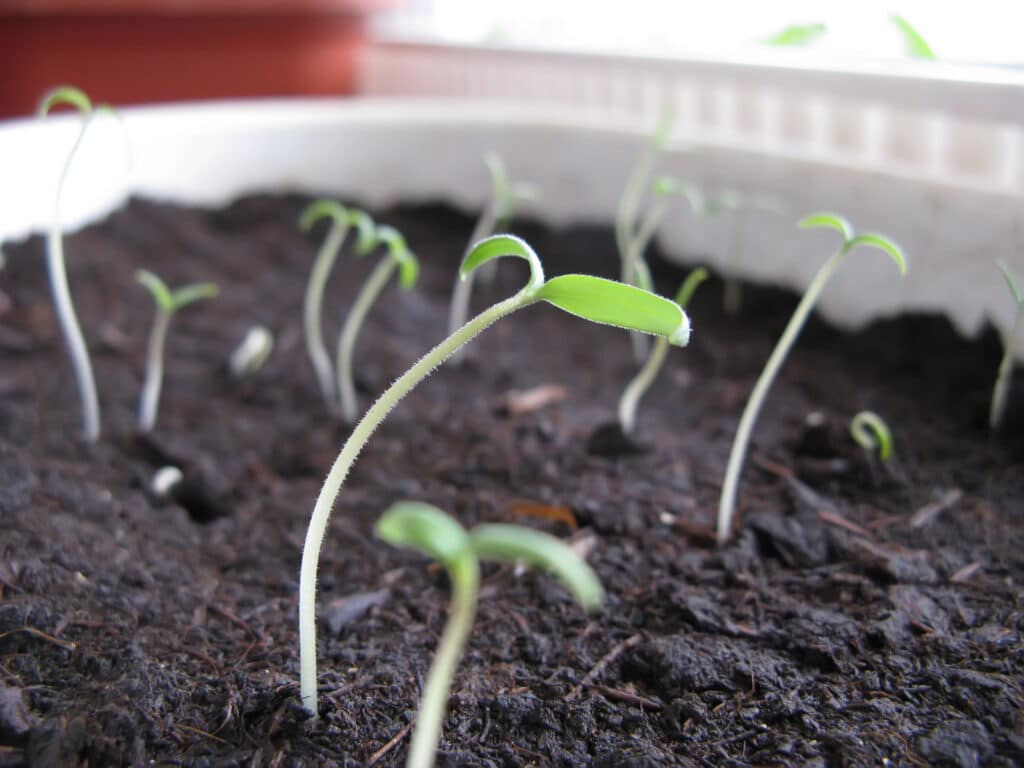
Grow Light
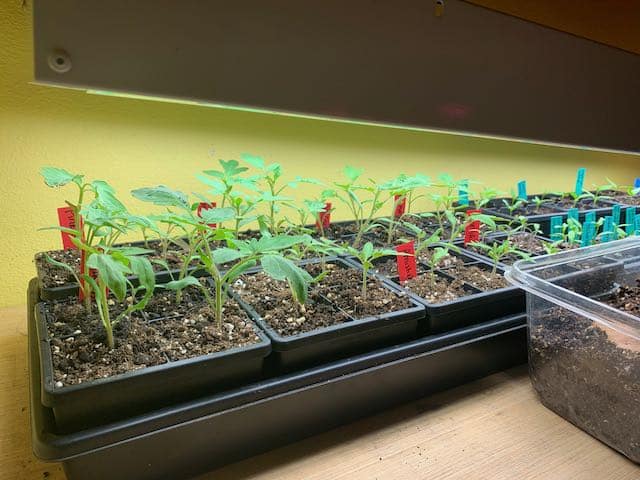
In order to prevent leggy seedlings you’ll need to get a grow light. Make sure the light is close enough to the top of the plant (3-6 inches depending on the light). The closer you can get the light to the top of your seedlings the better. (Note that if you own high-powered LED lights that you may not need it this close; always read the manufacturer’s instructions.)
Overplanting
The next way to prevent leggy seedlings is to make sure you don’t overplant your cell with too many seeds. Most of your seeds will germinate and you eventually will only want one plant growing per cell, in most cases. If you overplant, you will not only waste seeds, but also each of those seedlings will compete against each other for light, space, and ventilation. This competition results in stressed and leggy seedlings.
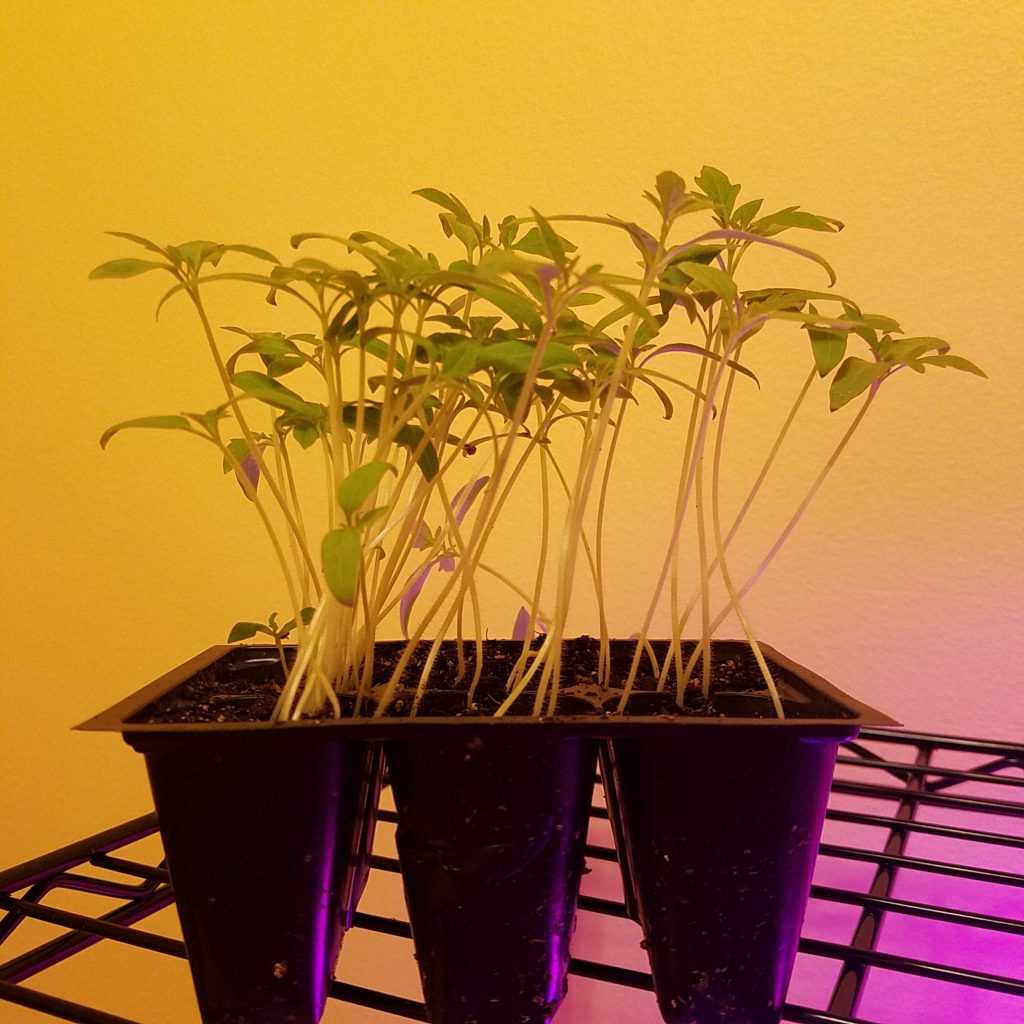
Heat Mat
Moving on to our next reason why your seedings might be leggy is from your heat mat. Use the heat mat until your seeds sprout. Once germination has occurred, you’ll want to turn off your heat mat so your soil doesn’t get too warm.
Think about how you feel when you’ve been under an electric blanket for too long. You want to get away from the heat. The same can be said for our seedlings. While heat hastens germination, hot soil isn’t the best environment for young plants.
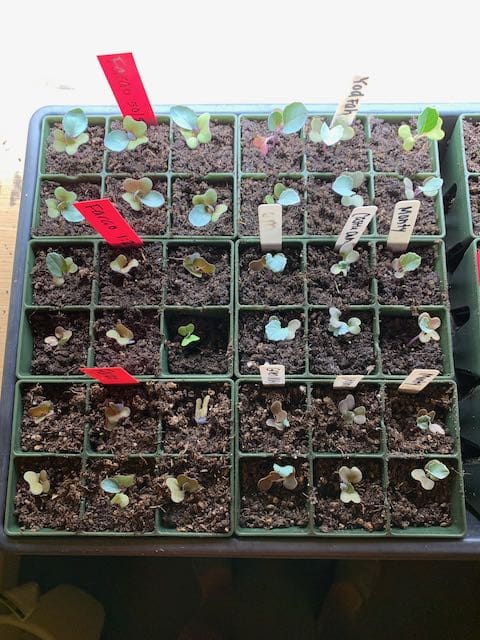
Fertilization
Finally, our last reason your seedlings might be leggy is if you use too much fertilization, especially with synthetic fertilizer sources, which contain a higher concentration of nutrients.
If seedlings get too many nutrients too soon, rapid growth will ensue, but their root systems can’t support the growth yet. Your best bet is to delay any fertilization until you pot up your seedlings. Don’t be in a rush to fertilize your seeds.
Indoor Seed Starting Problem #2: Stunted Seedlings
Next, let’s talk about how to prevent indoor seed starting problem number two: stunted seedlings. Stunted seedlings are seeds that aren’t growing very well, they don’t look healthy, or they are not progressing at the rate they need to progress.
Seed Starting Mix
The best way to prevent stunted seedlings is to use a good seed starting mix. You can opt to use a seed starting mix labeled for that purpose or take a high-quality potting soil and sift out the larger chunks. (I use the sifter listed here.)
Use care with seed starting mixes that have coir. Although I’ve used one brand with success, I’ve seen multiple instances of seedlings growing slowly in coir-based seed starting mix. It’s possible some coir-based mixes could have a high salt content, and it’s hard to know which ones that is. Hopefully as mixes improve, this will become less of an issue. Avoid mixes with moisture-retaining properties because they can retain too much moisture.
If you use a sifted potting mix, look at the ingredients and see if you see the words “wetting agent” on the bag. If your mix has a wetting agent, you will likely need to water less, but this also raises the risk of over-saturation (see below). To avoid this, don’t plant in a cell tray that is too large (and thus will retain too much water causing root rot. That brings us to the next tip.
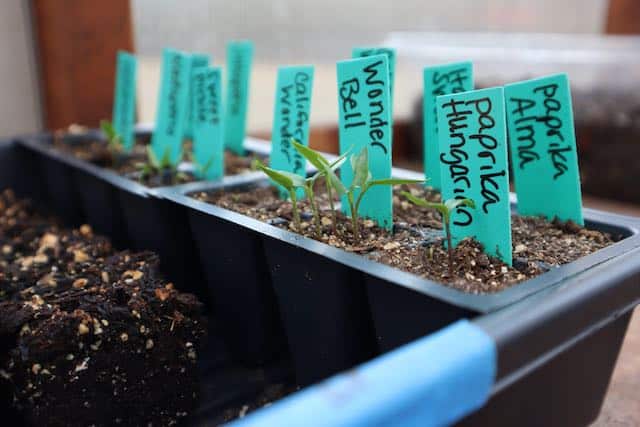
Cell Tray Size
Make sure to use the right size cell tray. If your cell tray is too small, your roots won’t have enough room to grow long term, and you will struggle with maintaining consistent water. If you choose to use too large of a cell, your soil might get too saturated. This is a problem because your roots need oxygen. I’ve seen more seedlings suffer from overwatering than under-watering, and sometimes the problem is simply growing too small of a seedling in too large of a cell.
Overwatering
Overwatering is our next problem that you might face when you have stunted seedlings. Overwatering can cause root rot.
Creating the “just enough but not too much” environment for moisture is a delicate dance that even seasoned gardeners still have to pay close attention to. My trick for maintaining ideal water regulation is to consider the weight of the tray. Essentially, I pick up my trays often enough to know, by weight, when the soil is saturated and when it is dry. (I go into further explanation in this Beginner’s Guide to Seed Starting Workshop.)
Fertilizing Too Soon
The next indoor seed starting problem that causes stunted seedlings is fertilizing too early. Do not before the true leaves appear. (The first leaves are not “true leaves;” they are seed leaves and the plant does not need fertilization at this point.)
Though gardeners differ on when to start fertilizing, I prefer to wait until I pot up my seedlings or until a few sets of true leaves appear. If you fertilize too early, you risk damaging the plant roots, which can keep your plants from taking up water efficiently.
Rest From Light
Next, make sure to give your seedlings rest from light. Don’t keep your grow lights on 24 hours a day – your plants need rest as well, so plan to keep your grow lights on for no more than 16-18 hours a day.
Room Temperature
Finally, make sure the temperature of your room is between 65 and 75 degrees. Temperature preferences will vary by the plant, but if you are attempting to grow in a cold basement or garage, you might need to warm up your room a little bit.
Indoor Seed Starting Problem #3: Wilting Seedlings
Our final problem I see every year that we want to prevent with indoor seed starting is wilting seedlings. Wilting seedlings can be caused by many different factors but most likely it’s a watering issue.
Overwatering
Are you sensing a theme? Not to belabor the point, but we tend to overwater our seedlings more than under-watering them. When you overwater your seedlings the seeds become starved for oxygen. Your soil needs oxygen pockets for the roots to grow and if you overwater, the water is filling that space.
One way to prevent this is to water your trays from the bottom (known as bottom-watering). When doing this, check in about 30 minutes to ensure the water has been taken up by the soil. If the trays continue sitting in water, you’ll need to drain out the excess water.
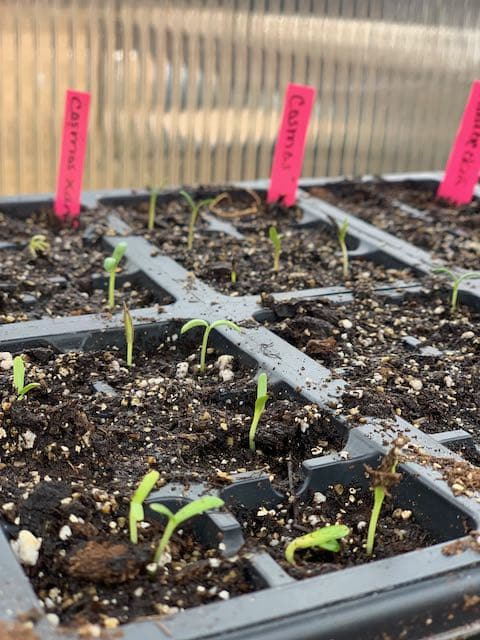
Underwatering
While overwatering is common, make sure you provide enough water. Your seedlings, of course, need water. Most of the time under-watering happens when we forget about our seedlings or forget to check on them.
Also, the larger your plants become, the more water they will need. As the roots expand to take up the space in each cell, they take up more water. Once you find yourself having to water once a day or multiple times per day, this is a sign that you want to consider potting the seedling up to a larger container.
Potting Up
When you transfer a seedling to a larger container — but still grown indoors or in a greenhouse — this is called “potting up.” By potting up, your seedling’s roots can expand into new space, acquiring needed nutrients and more water.
You will be amazed how fast your plants will grow within days of being potted up. I’ve learned not to keep my seedlings confined. If you’re watering daily or more, and if you notice the roots starting to reach the edges of the pots, potting up is in order. Watch how to pot up your seedlings here.
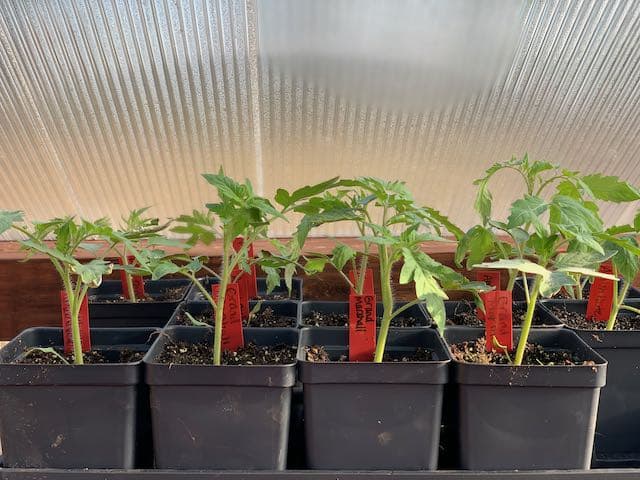
Ensure Gardening Success
If you can prevent these three very common seed starting problems you will be well on your way to a successful planting season this year. It’s important to fix problems before they begin and my hope is that I’ve been able to help you identify the three most common seed starting problems I see like leggy seedlings, stunted seedlings and wilting seedlings. By preventing these common issues, you’ll have a better chance of a successful planting season.
While these three problems are the most common, there are others. To get my Seed Starting Troubleshooting Guide, which includes problems, causes, preventions, and remedies, click here.

